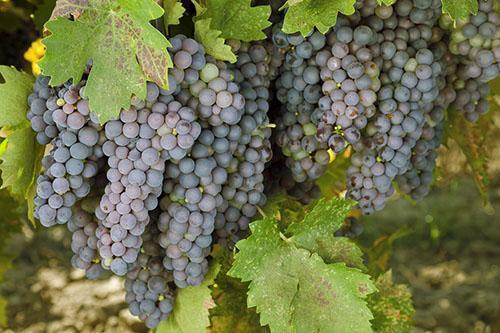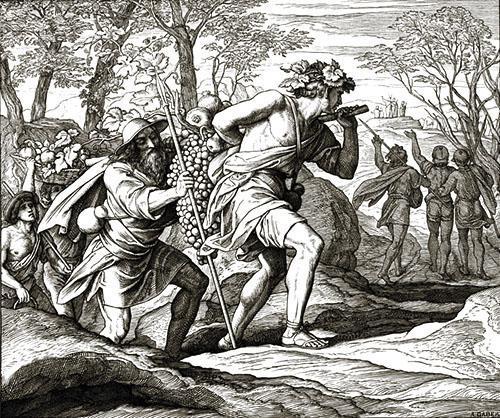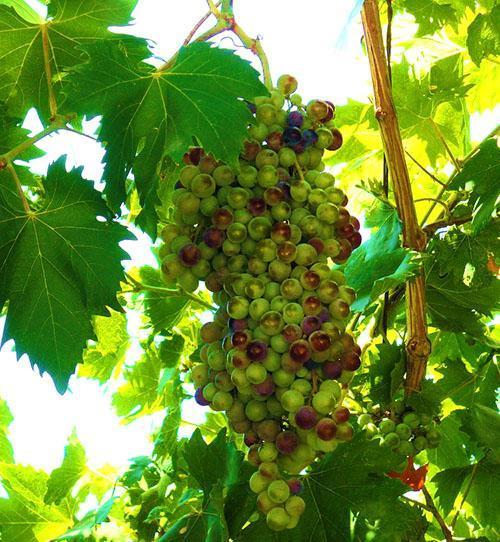All about grapes: types, varieties and the path to perfection
 It is difficult to overestimate the importance of grapes in the life of a modern person and all of humanity. He became one of the first agricultural crops, wine and vinegar from ancient times played a significant role in the development of trade and navigation. Many historical facts and events are associated with grapes. It is impossible to tell everything about grapes, but the mere fact that a whole science is engaged in plant and its cultivation - ampelography, deserves attention and respect.
It is difficult to overestimate the importance of grapes in the life of a modern person and all of humanity. He became one of the first agricultural crops, wine and vinegar from ancient times played a significant role in the development of trade and navigation. Many historical facts and events are associated with grapes. It is impossible to tell everything about grapes, but the mere fact that a whole science is engaged in plant and its cultivation - ampelography, deserves attention and respect.

Since that time, the zone of distribution of the heat-loving culture has expanded significantly. And today the vine cannot be found except on the Antarctic continent. In total, more than 10 million hectares are allocated for wine and table grapes in the world. With the development of breeding and industrial technologies, grape varieties are becoming increasingly important not only for winemaking, but also for fresh use, for the production of juices and raisins.
Classification of grapes: types and origin
 In total, in the genus Vitis, according to the existing classification, there are more than seven dozen species, distributed in three groups:
In total, in the genus Vitis, according to the existing classification, there are more than seven dozen species, distributed in three groups:
- European-Asian;
- East Asian;
- North American.
The European-Asian group is, in fact, a species of Vitis vinifera, the cultivated subspecies of which gave the largest number of technical and table grape varieties that exist today. According to the classification of A.M. Negrul, they are divided into three geographical groups:
- orientalis - oriental;
- occidentalis - Western European;
- pontica - originating from the Black Sea coast.
 Of the 28 species that make up the American group, three are well known and cultivated. At the same time, Vitis labrusca is not only the ancestor of most American varieties, but also the species, whose descendants, due to their unpretentiousness and productivity, are the most widespread in the world. Berries of this type are easily recognized by their peculiar taste, which is often called "fox" or strawberry. An example of the most common natural hybrid of the European and American type is the technical grape variety Isabella, whose history goes back almost two centuries.
Of the 28 species that make up the American group, three are well known and cultivated. At the same time, Vitis labrusca is not only the ancestor of most American varieties, but also the species, whose descendants, due to their unpretentiousness and productivity, are the most widespread in the world. Berries of this type are easily recognized by their peculiar taste, which is often called "fox" or strawberry. An example of the most common natural hybrid of the European and American type is the technical grape variety Isabella, whose history goes back almost two centuries.
 The largest East Asian group of grapes includes 44 species, of which only one has been studied and used in viticulture. This is Vitis amurensis - Amur grape.
The largest East Asian group of grapes includes 44 species, of which only one has been studied and used in viticulture. This is Vitis amurensis - Amur grape.
Today, in professional and amateur farms, bushes are grown, giving rounded and elongated berries of all shades from almost black and purple to amber yellow and greenish.
Moreover, white grapes are also the result of selection work, but carried out by nature itself. All wild-growing grapes produce dark berries, but as a result of a spontaneous mutation, which has successfully established itself, some of the plants have lost the ability to produce anthocyanin coloring fruits. This is how white grape varieties appeared.
 However, grapes are not only a plant that produces juicy berries, but also a spectacular decorative liana. Therefore, certain species, for example, Amur and girlish grapes, as well as Isabella are actively used in landscape design and gardening. There are even indoor grapes. This is a distant relative of the cultural representatives of the genus Vitis - cissis, in the shape of the leaves and the appearance of the bush, resembling their fruit-bearing brothers.
However, grapes are not only a plant that produces juicy berries, but also a spectacular decorative liana. Therefore, certain species, for example, Amur and girlish grapes, as well as Isabella are actively used in landscape design and gardening. There are even indoor grapes. This is a distant relative of the cultural representatives of the genus Vitis - cissis, in the shape of the leaves and the appearance of the bush, resembling their fruit-bearing brothers.
Modern grape varieties and selection of new varieties
If we talk about the existing grape varieties, whose berries have long and firmly entered human life, then there are more than 20 thousand of them in the world, and the overwhelming majority are hybrids, in the genotype of which there is a European cultivated grape, American Labrusca and Amur species.
 Each of this species has its own advantages and disadvantages, therefore, breeders are actively working to highlight the best features and obtain new table and technical grape varieties:
Each of this species has its own advantages and disadvantages, therefore, breeders are actively working to highlight the best features and obtain new table and technical grape varieties:
- with high winter hardiness;
- with large, sweet or seedless berries;
- with earlier ripening periods;
- with abundant regular harvests;
- with good resistance to diseases and pests.
Back in the middle of the last century, Michurin was able to obtain stable hybrids of winter-hardy Amur grapes and unpretentious American varieties, many of the early varieties of grapes used and still used, which made it possible to significantly expand the boundaries of viticulture in the Soviet Union.
More than half of the regions where grapes are grown in Russia are classified as zones with a sharply continental climate.
This means that the vine must withstand:
- harsh winters;
- frosts, inevitable in spring and autumn;
- lack of moisture in the spring and summer months;
- early rainy season, during ripening or harvesting.
On the basis of the varieties obtained in the Soviet years, such frost-resistant grape varieties as Codryanka, Vostorg, Original, which themselves have already become "parents" for several generations of fruitful hybrids, have been bred.
Grape ripening terms
The most important problem is the problem of obtaining grape varieties for wine and dessert purposes, with a short growing season.
 It is believed that the ability of a plant to quickly form a crop depends on many factors, the main one of which is genetic predisposition. However, in different climatic and weather conditions, grapes of the same variety can yield a harvest with a time difference of 1–2 weeks.
It is believed that the ability of a plant to quickly form a crop depends on many factors, the main one of which is genetic predisposition. However, in different climatic and weather conditions, grapes of the same variety can yield a harvest with a time difference of 1–2 weeks.
In addition, there are significant differences in phenotype between varieties of northern and southern origin. For example, an early grape variety of northern origin not only gives a sweet berry in a short time, but also has time to prepare for winter. During the growing season, its vine ripens. Southern varieties with the same ripening periods often cannot boast of such a property, their vine ripens after harvesting the bunches. And in ripe berries, unformed seeds are often visible.
The period from the moment when the buds burst until the onset of ripeness of berries in varieties of different maturity is:
- very early ripening of 105–115 days;
- early ripening 115–125 days;
- medium ripening 125–130 days;
- medium late ripening 130–140 days;
- late ripening 140-145 days;
- very late ripening more than 145 days.
True, there are already very early grape varieties that, under favorable growing conditions, are ready to please with a harvest in 90–95 or even 85 days.
Frost resistance of grapes
 But even when growing varieties with short growing periods, it is impossible to obtain any significant yield if the plants do not possess the required winter hardiness and are not able to survive during seasonal frosts and winter colds. Frost-resistant grape varieties are indispensable in Russian conditions with a continental climate, where, along with hot summers and in the southern regions, winters are rather severe.
But even when growing varieties with short growing periods, it is impossible to obtain any significant yield if the plants do not possess the required winter hardiness and are not able to survive during seasonal frosts and winter colds. Frost-resistant grape varieties are indispensable in Russian conditions with a continental climate, where, along with hot summers and in the southern regions, winters are rather severe.
According to the accepted classification, varieties are divided into four groups:
- weakly resistant, wintering at temperatures from –15 to –17 ° C;
- medium resistant, withstand cold temperatures from –18 to –22 ° C;
- with increased resistance, surviving in frosts from –23 to –27 ° C;
- very resistant to frost, withstand temperatures from –28 to –35 ° C.
Interestingly, the ability of grapes to withstand cold can change throughout the year.
During the period of intensive growth, a sudden cold snap to –3 ° C can completely destroy the bushes of even frost-resistant grape varieties, which practically lose this property in the summer. The shoots at this time are watered with juices, lignification is insignificant, and the plant does not have protective substances and reserves. By autumn, winter hardiness grows and reaches a maximum by January. At the same time, perennial wood is more protected than annual shoots. And the place where the scion and rootstock grow together is the most sensitive.
 When growing non-covering grape varieties, it must be borne in mind that the buds on the bush also have a different degree of protection from the cold:
When growing non-covering grape varieties, it must be borne in mind that the buds on the bush also have a different degree of protection from the cold:
- Dormant kidneys are safer.
- In second place are the replacement, lateral kidneys.
- The central buds most often suffer from frost and winter chill.
Frost resistance of grape varieties depends not only on meteorological conditions, but also on the location of the vine in a particular area, its age, the degree of readiness for winter, damage by diseases and pests.
Table grape varieties
 The most active selection work goes towards obtaining new varieties, the berries of which are consumed fresh. Exactly table grape varieties today it ranks first in popularity among both amateur gardeners and professional winegrowers.
The most active selection work goes towards obtaining new varieties, the berries of which are consumed fresh. Exactly table grape varieties today it ranks first in popularity among both amateur gardeners and professional winegrowers.
Table grapes can be easily distinguished from the total mass by a number of characteristics:
- the size and attractive shape of large brushes;
- beautiful color, shape and size of berries;
- pronounced aroma and taste of ripe fruits.
When breeding such varieties, much attention is paid to reducing the acidity of berries, yields and obtaining large fruits and full clusters. A number of agrotechnical measures that are not carried out on grape varieties for wine purposes are also aimed at this. Among these techniques:
- artificial pollination;
- rationing of brushes and inflorescences;
- thinning berries on bunches;
- removal of shading brush leaves.
The yield and quality of table grape varieties also depend on the climate, relief and soil on which the vine grows.
 If earlier the harvest of table grape varieties was practically not stored, today there are varieties, both for local consumption and withstanding transportation and very long storage.
If earlier the harvest of table grape varieties was practically not stored, today there are varieties, both for local consumption and withstanding transportation and very long storage.
Seedless grape varieties
 Seedless grape varieties are increasingly popular with winegrowers, the berries of which are either completely devoid of seeds, or have only their rudiments. Such berries are in demand not only fresh, juices are made from grapes, seedless raisins are especially valued. The lack of seeds is a serious factor in attracting consumers, therefore, until recently, a small group is rapidly expanding, replenishing with hybrids and varieties of pink, black and white grapes of different ripening periods and purposes.
Seedless grape varieties are increasingly popular with winegrowers, the berries of which are either completely devoid of seeds, or have only their rudiments. Such berries are in demand not only fresh, juices are made from grapes, seedless raisins are especially valued. The lack of seeds is a serious factor in attracting consumers, therefore, until recently, a small group is rapidly expanding, replenishing with hybrids and varieties of pink, black and white grapes of different ripening periods and purposes.
It is generally accepted that seedless grapes are represented by two types:
- kishmish belonging to the eastern group of grapes;
- corinka belonging to the group of the Black Sea basin.
It is Kishmish that is considered one of the most massive varieties in the world. But if on store shelves grapes with a rather small, but extremely sweet berry are still more often found, today breeders are already offering boneless early grape varieties with large fruits of black, white and pink color.
Technical grape varieties
 Since technical grapes are intended for processing, its main distinguishing feature is the juice content. The amount of juice obtained from the berries of technical or wine grape varieties can reach 75–85%.The second important indicator is the ratio of the mass of the comb and the weight of the berries on the brush. The denser the brush and less weight on the comb, the more valuable the raw material.
Since technical grapes are intended for processing, its main distinguishing feature is the juice content. The amount of juice obtained from the berries of technical or wine grape varieties can reach 75–85%.The second important indicator is the ratio of the mass of the comb and the weight of the berries on the brush. The denser the brush and less weight on the comb, the more valuable the raw material.
At the same time, the appearance of the bunch, the harmonious color and size of the fruit are not so important. Much more attention is paid to the mechanical and chemical composition of berries, sugar content and acidity, on which the type and quality of the products will depend. Getting a decent harvest on technical grapes depends not only on the genetic and biological characteristics of the plant, but also on the growing conditions. It is not without reason that there are vineyards that have been around for several centuries and are famous for their excellent wine.
Connoisseurs are well aware that the quality of the wine and its bouquet, in addition to the geographical and climatic aspect, is influenced by the specific location of the vine. For example, the saturation of the color of the berries of wine grape varieties directly depends on the illumination, the direction of the rows and the geometry of the slope on which the bushes grow. Thanks to the unique characteristics of individual varieties, for example, the flavor shade, like Cabernet, or the aroma, like existing varieties and hybrids of Muscat, winemakers manage to get interesting, unlike other wines and drinks.
 If table grape varieties are usually not tied to any particular locality, then for technical varieties, the division into indigenous and introduced is relevant. Moreover, local varieties of technical grapes are highly valued and are raw materials for the manufacture of sometimes unique brands of wines, whose production in another area is simply impossible.
If table grape varieties are usually not tied to any particular locality, then for technical varieties, the division into indigenous and introduced is relevant. Moreover, local varieties of technical grapes are highly valued and are raw materials for the manufacture of sometimes unique brands of wines, whose production in another area is simply impossible.
The article is very curious and interesting! Thanks to the author!